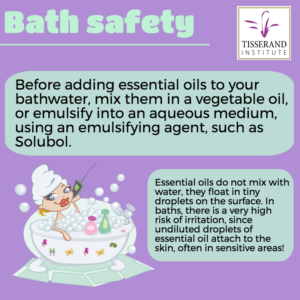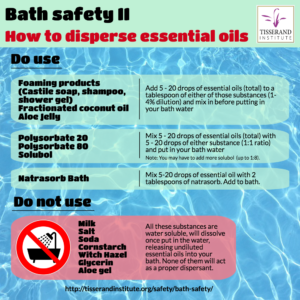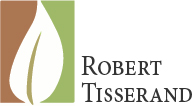In a recent blog post Jade Shutes challenges the safety guidelines for using essential oils in the bath published on TisserandInstitute.org. She also feels that there is an increasing (and in her opinion unfortunate) trend to cite research. Jade proposes that this is not good because research is cited at the expense of personal experience. One example is given: “We will not find broad acceptance as an adjunct to healthcare if we pass over evidence-based research for the under-evaluated claims or perceived results of an individual.” This seems to me an entirely reasonable statement, and I don’t see that it points to a general trend in the aromatherapy community to “suppress individual experience”. The first eleven words of the quoted statement make the context quite clear.
Jade states: “We want to know how, if, and when (etc.) essential oils work in the real world, with real people, with real life happening every day, right? This is so much more valuable then simply quoting from research papers.” Thus, Jade sets up a conflict between personal experience and research. She complains that people are citing research instead of personal experience, which she says is much more valuable, and yet “it is often negated”. What kind of research is not stated, but it appears that all research is of less value. Why an individual’s experience would be “more valuable” than a clinical trial is not clear.
The connection between bath safety and research seems to be that because essential oils don’t dissolve in water, I am saying they are unsafe in the bath. Jade claims that this is actually not true. However, the fact that essential oils don’t dissolve in water is simply a fact. And, I don’t cite any research to support the idea of risk in bathwater – I cite individual experiences. There are several issue to address in Jade’s blog post:
* What type of dispersants are safe to use in the bath?
* Are safety guidelines useful?
* Research vs personal experience – why the conflict?
Jade’s example of why research should not be used as a reference point for bath safety, is an infographic posted on Tisserand Institute, which she credits to me. However, the infographic is merely a brief summary of a page on TI, as well as a complementary piece to another infographic. This was written by Deborah Kallevig, who is an experienced formulator, but I certainly approved it. Jade refers to the infographic as “incredibly insulting”, because she feels that “they are talking to us like we are children”. She further comments that we are being asked to “ignore our history and experience with using essential oils.” Surely not, but perhaps we are being asked to review what we thought we knew about bath safety.
Jade is pitting me/the Tisserand Institute (TI) against the rest of the aromatherapy community, on the basis that the safety advice TI gives is based on research, rather than on personal experience. This is simply not true. Jade claims that thousands of products containing essential oils without any of the dispersants recommended by TI have been used over many years, with no adverse reactions. My response – how do we know there were no adverse reactions? What evidence is there? Most of the adverse events that occur with commercial products are not reported at all, or if they are do not become public knowledge. I know because I have been formulating products for companies for more than 40 years.
What type of dispersants are safe to use in the bath?
Jade acknowledges that undiluted essential oils in bathwater can cause, and have caused, adverse reactions. However, she believes that the reasons for this include too many drops of essential oil, using adulterated essential oils, skin sensitivity, and other factors. Her core message seems to be that using undiluted essential oils in the bath is actually safe if done properly, and if the person has no previous skin sensitivity issues. If so, we fundamentally disagree. And I have to wonder whether the products she refers to include warnings about skin sensitivity. Or children.

When I first started talking about essential oils publicly, in 1981, I advised people to add a few drops of any essential oil to their bathwater, and my guideline then was up to about 5 drops. I said that because at the time I thought it was safe – that was my personal experience. By 1985 I had changed my advice, saying that the oils had to be first diluted/dispersed in either fatty oil or a foaming base. I changed my mind not because I read some research, but because I burned my butt in the bath one day. I think it was Peppermint oil – I don’t remember for sure – but it was only 1 or 2 drops. That was enough. I also spoke to other people who had similar experiences.
My bathing calamity prompted two observations: (1) that the essential oils float in a film on the surface of the water, and (2) that second part of my body to enter the water (after my feet) was a very sensitive area, to which the film of essential oil would adhere. A further consideration is that the film of essential oil adhering to my skin cannot evaporate, and that it’s held in place by hot water. This is pretty much an ideal situation for skin irritation, which is usually what happens (not sensitization).
I think it’s possible that Jade and I agree that essential oils in the bath should really be properly dispersed, for safety reasons. I’m not sure because she’s not abundantly clear. But what we disagree on is which substances are dispersants, and what “dispersion” actually means. Jade claims that Epsom (or other) salts, honey and full-fat milk are dispersants. I disagree, because none of these dissolve essential oils in water. This is explained in detail here http://tisserandinstitute.org/safety/bath-safety/. Salts and full-fat milk do have a slight dispersing effect, in that the film of essential oil is marginally more spread out on the surface of the water. Perhaps this reduces risk to a small degree, but you will still have undiluted essential oil adhering to random areas of skin. Does this actually present a risk? Let’s look at what happens in the real world.
Undiluted essential oils can most certainly cause redness and irritation: “Before I knew better, I used bergamot in my bath water, and got quite a reaction to it. I had a burn on my arms, back, shoulders and neck that resembled a sunburn. I learned my lesson there.” Full report here. “I had a very uncomfortable reaction when I put a few drops of grapefruit essential oil in my bath. My entire backsi
de felt like I sat down in a stinging nettle patch! The itching/burning stinging was fairly intense for about a half hour.” Full report here.

But even when “dispersed” in full-fat milk, reactions are possible: This was one mother’s experience: “I added several drops of tangerine essential oil to a cup of full fat milk and poured it into a warm bath for my two girls, aged 2 and 4. After a few minutes they started saying it was hurting. I immediately pulled them out, dried them off and applied virgin coconut oil. By this time they were both hysterical, crying and saying it was hurting. I washed them off with soap and lukewarm water then applied more coconut oil. After that the burning seemed to improve but they were still upset for about an hour afterwards. It broke my heart to see my babies hurting because I didn’t properly dilute the oils.” Full report here.
Similar adverse events can happen in adults: “I have several times experienced burning and skin-reddening on using Lavandula angustifolia EO (without other EOs) in a warm bath. This has been both with and without mix
ing first with oil, bubble bath or milk. The maximum amount was 5 drops, but it has happened even with 2 drops. The reaction comes after about 10 minutes. Surprisingly, I regularly apply lavender undiluted topically for burns, bites, etc with no adverse reaction. I have not noted a similar reaction to other oils in a bath, barring the citruses.” Full report here. This account supports the argument that essential oils in the bath are more likely to cause adverse reactions than when applied topically. So, based on my personal experience, which was repeated several times with various essential oils, and the experience of others, I maintain that essential oils should be completely dissolved before adding to bathwater, for safety reasons.
Are safety guidelines useful?
This is a broad question, though bath safety is part of it. The fundamental issue is this – most people don’t have adverse reactions to essential oils, but in order to protect the minority who do, we have safety guidelines, and these are encapsulated in a book I co-authored in 2014. The point is to reduce risk as much as possible, without significantly losing benefit. With essential oils in the bath, there is simply no good reason not to properly dissolve the essential oils. This reduces risk without impacting benefit. Here’s what Rodney Young and I say in the book: “Whenever essential oils are ‘mixed’ with water without a dispersing agent, there is a risk of irritation, since undiluted droplets of essential oil can attach to the skin, sometimes in sensitive areas. Therefore, essential oils should first be dispersed in a vegetable oil, or emulsified into an aqueous medium by use of an emulsifying agent. Full-fat milk helps to disperse essential oils in this way. However the dispersion is not complete, so this is not a perfect solution for anyone who might be sensitive, such as children or those with a skin disease.” I have now modified my position on full-fat milk, to simply say it should not be used at all as a dispersant.
I’m not sure if Jade believes in safety guidelines – the only safety issue I have heard her refer to is that Cinnamon bark oil should not be used on the skin. I would not agree, but that’s not important – we both acknowledge that it’s a potential skin sensitizer. In an attempt to find out whether the cosmetic industry guidelines for Cinnamon bark oil safety applied to real-world use of the essential oil, the Tisserand Institute carried out a survey, reported here . We concluded that the industry guideline was useful, but that many essential oil sellers either were not aware of it or chose to not follow it. This was not research published in a peer-reviewed journal, it was a survey of personal experiences. Similarly, we conducted a Facebook poll to find out whether Peppermint oil could reduce milk supply in breastfeeding. We did this because there was no useful published research on the subject. Yes, collective information from individuals can be extremely useful.
Individual case reports are incredibly valuable as contributions to the collective safety information, whether they point to contraindications, adverse skin reactions, drug interactions, or whether they clearly indicate safety. They help enormously to guide the future safe use of essential oils. And yet, while Jade talks up the importance of personal experiences, when these take the form of adverse reaction reports, she looks for reasons as to why they are not representative of reality (impure oils etc).
Research vs personal experience – why the conflict?
Individual case studies can have value in therapy, depending on how well they are carried out and how well they are written up. Jade complains that citing research is a negative trend, and that collective personal experience is more valuable. I really don’t see any need to create conflict here, especially when none actually exists! All information is potentially useful, and when we combine case information with clinical studies or other research, this very often helps us to see the “big picture”. This is especially important when information impacts large numbers of people who are not under the direct supervision of a practitioner. This is the situation in regard to social media.
Also, it’s worth noting that clinical trials won’t happen unless there has been previous experience suggesting a significant therapeutic effect. This may take the form of individual cases, or pilot studies with small groups. Although the clinical use of Lavender oil is now based on more than 300 research studies, this was initially championed by practitioners.
The limitations of case studies include that they typically include many factors, so we may not end up knowing what did what, and that comparing one case study to another is fraught with inconsistencies. This does not mean the information useless, but it is the main reason that we have clinical trials. They help us understand whether an intervention is really effective, whether it is safe in practice, and what does what. Research – often non-clinical – helps us comprehend how an essential oil does what it does – it’s mechanism of action. Individual experience cannot address this, and it helps us understand for example why an essential oil may work better on some individuals than others, how it should be applied, and may even suggest new potential uses.
Contrary to Jade Shute’s claim, herbal medicine is not only founded in practice, it’s equally founded on research. “Herbal products are complex mixtures, and for such complexity, an obvious approach for mechanistic studies is network pharmacology based on omic tools and approaches, which has already begun to revolutionize the study of conventional drugs, emphasizing networks, interactions, and polypharmacological features behind the action of many drugs.” https://www.ncbi.nlm.nih.gov/pmc/articles/PMC4032837/ And again, there’s absolutely no need to create conflict here. All information is potentially useful.
In order to meaningfully discuss both the benefits and risks of essential oils, we need objective information, and that’s why research exists. Clinical research is what is moving aromatherapy forward, allowing it to be increasingly accepted by the medical and scientific communities, and allowing it to be increasingly used in hospitals, clinics and hospices, to address challenges such as postoperative pain, diabetic neuropathy, sleeping difficulties and chronic itch. The use of essential oils to treat fungal skin infections and in wound healing is starting to become more accepted. Research is the only reason that we are able to purchase and use encapsulated essential oils. None of this would be possible if all we had was anecdotal evidence. We would still be sidelined as quacks, as we most definitely were in the 70s and 80s, before Ms Shutes began her aromatic journey.




Perfectly stated!!! This is exactly how true teaching should be done. ALL relevant information should be presented so people can properly weigh risk vs benefits and be able to make an educated informed decision on what is right for them.